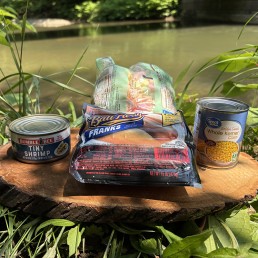Supermarket Baits
SHARE THIS POST
Not all baits need to be purchased at bait shops. Some valuable baits can be conveniently purchased in a supermarket. These “human foods” can be used to catch fish. Supermarkets are easier to find than bait shops, and many are open 24 hours a day. Moreover, many supermarket baits do not need to be stored in a refrigerator or need special containers. For example, minnows need to be kept in cool water with air bubbling through it to provide oxygen for the minnows.
Many spouses strongly object to storing worms, maggots, and mealworms in their kitchen refrigerators. They believe that these baits will contaminate the food. Finding a worm crawling in the refrigerator may result in a major disagreement about storing bait in the fridge.
Canned corn
Canned sweet corn kernels are a good bait for stocked trout, carp, and catfish. A small can of whole kernel corn is cheaper than worms or mealworms. For trout, place one or two kernels on a size 10 hook. Cast it upstream and allow it to drift through a pool with moderate current. Current causes the kernels to tumble, which attracts trout.
If legal, chum an area with corn for carp. The best areas have little or no current so that the chum remains in one place. Carp will become accustomed to feeding on corn. Cover a size 6 hook with corn and casts to where the chum is. A carp will inhale the corn-covered hook. Set the hook and be awarded with a fighting carp.
Catfish can also be caught on corn, using carp tactics.
Velveeta cheese
While numerous trout have been caught using different cheeses, the best cheese to use is without a doubt Velveeta. This cheese melts slowly in the water, emitting scent for trout to follow to the source. The yellow-colored cheese turns white as it melts. Place a hunk of Velveeta about the size of your fingernail on a size 8 hook. Cast into a lake and let it lie on the bottom.
Do not be surprised if a catfish grabs your chunk of Velveeta. Catfish are very good at detecting scents in the water and will follow the scent to its source, much like a bloodhound.
Marshmallows
Miniature marshmallows can be used to catch stocked trout. If fact, bait manufacturers infuse marshmallows with flavors to better attract trout. Regular miniature marshmallows will catch trout, too. This bait has the advantage of being lighter than water; thus, it floats.
Place a single marshmallow on a size 8 hook. Because marshmallows are very light, a sinker is needed to cast a marshmallow any distance. The marshmallow will float above bottom debris and algae, making it visible to trout. Stale marshmallows are preferred because they are slightly harder and stay on the hook better. Using colored marshmallows allows trout to select the color that they prefer. The preferred color may change daily or even hourly.
Bread
White bread can catch many different fish, from bluegills to carp to catfish. Stale bread is frequently sold to visitors for feeding ducks. Carp come to the surface and compete with the ducks for the tossed bread pieces.
Are you enjoying this post?
You can be among the first to get the latest info on where to go, what to use and how to use it!
Form a small ball of bread around a size 10 hook for bluegills. Add a split shot or two is used for casting bread. A small bobber suspends the bait.
For carp and catfish, form a large wad of bread around a size 6 hook. Like corn, bread can be used to chum an area to attract carp and catfish. Typically, the wad is cast into a lake with a sinker and the wad rests on the bottom.
Shrimp
Shrimp mimic crayfish tails to fish. Canned shrimp is cheaper than buying crayfish. Smallmouth bass and large trout relish crayfish and are attracted to shrimp. Bluegills, although primarily an insect eater, are attracted to tiny, canned shrimp as well. To catch trout and bluegill, place a single tiny shrimp on a size 10 hook. For bluegills, use a long-shank hook which is easier to remove from their small mouths.
Try medium canned shrimp for smallmouth bass. Use a size 6 hook baited with medium shrimp, fished on a lake or stream bed.
Hot dogs
Hot dogs are a convenient catfish bait. Slice a hot dog into pieces about a half-inch thick. Thread a chunk onto a size 6 hook and, using a sinker, cast into a lake or stream. Catfish will detect the scent and follow the scent to the hot dog.
Oily fish
Supermarkets sell oily fish such as mackerel. The fish should be fresh or frozen. Canned fish is usually too soft to remain on the hook during a cast. Cut the mackerel into 1-inch chunks to catch catfish. Thread the chunk onto a size 4 hook and fish it on a lake or stream bed. The oily scent attracts catfish. Larger catfish are usually caught on oily fish chunks more than on other supermarket baits.
As described above, supermarkets can be good sources of fishing baits. Many of these baits are far cheaper and are easier to store than nightcrawlers and minnows. And if no fish are caught for lunch, you can always eat the bait!
For more insight and tips for fishing throughout the year, check out the articles in every issue of MidWest Outdoors, available by subscribing on our website.
MWO
SHARE THIS POST
You may also like...
Nothing found.
Did you enjoy this post?
You can be among the first to get the latest info on where to go, what to use and how to use it!
